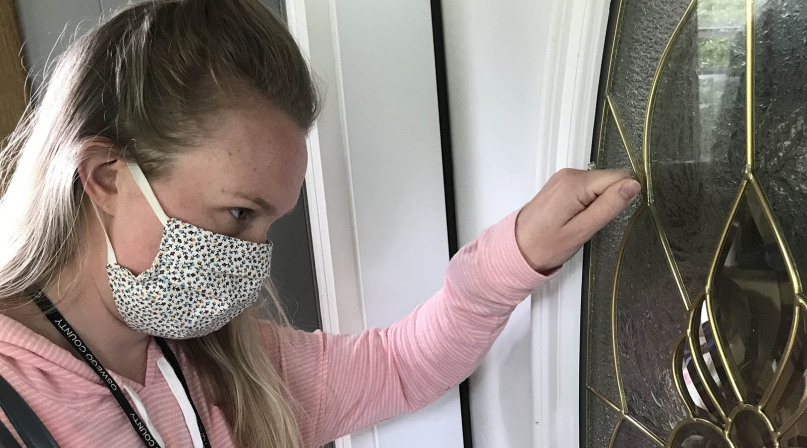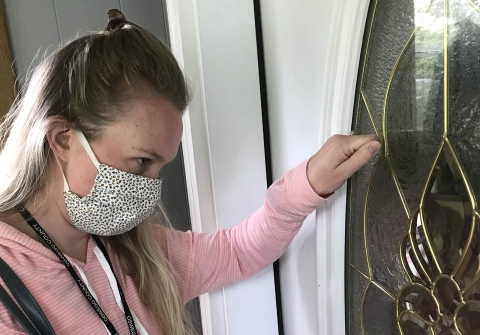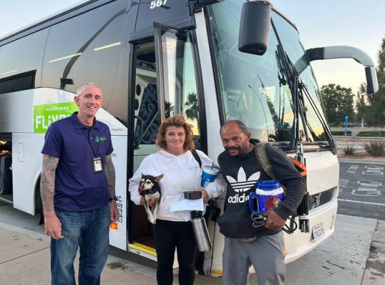Faces on the Front Lines: Child protective caseworker Christina Lee
Author
Upcoming Events
Related News

Protecting the country’s youngest population can be a challenging feat during a public health crisis.
County department of social services employees such as Christina Lee, a child protective caseworker in Oswego County, N.Y., are working to protect children under a variety of new and challenging circumstances.
Here’s a look at how Lee is continuing to do her job during the COVID-19 pandemic.
Mornings
Lee spends the majority of her week working from home. Her commute now consists of the short distance between her bed and the kitchen table where she spends her days working on a laptop.
“I have a 30-minute commute to the office, so I have more time if I just get right from my bed to my kitchen table,” she said.
Learn More
NACo’s We Are Counties Campaign puts faces on the frontline services counties provide.
Every morning, Lee pulls up a to-do list she wrote from the day before to check deadlines and case updates. Her mornings consist of reviewing cases, writing notes or calling families or contacts who can provide insight into a family’s situation.
When making phones calls, Lee makes another short commute from the kitchen table to her car outside because of confidentiality issues. She has a husband and daughter at home, preventing her from taking calls inside the house.
“I’ll go into my car so I’m in there by myself, kind of isolated and I bring my laptop in there because I type while I’m on the phone,” she said.
The department has allowed video chatting on a case-by-case basis during the pandemic instead of interviews in person. Virtual interviews also require the commute to the car where Lee brings her laptop and speaks to families.
“[This is] to make sure that we are keeping the safety and well-being of ourselves and our clients into consideration,” she said.
Once a week, Lee spends her morning making a real commute to the office where the Oswego County Department of Social Services restricted the number of employees allowed at any given time. Each case worker is designated a certain day of the week to work from the office.
Her main focus at the office is paperwork — scanning physical evidence into a digital filing cabinet, printing letters to send and faxing questionnaires to doctors or school staff.
“I try to get in there early like 8:30 a.m. and then I try to only stay until about noon so I’m limiting my amount of time that I’m in the office to just a couple of hours a week to limit my exposure risk,” she said.
At the office, protocols are in place. Everyone is required to wear a face mask, deputies who serve as security for the office take everyone’s temperature and employees use hand sanitizer before going upstairs to their desks. Lee said she can take off her face mask at her cubicle but must put it back on when walking around common areas.
Afternoons
Following her work in the office on Tuesday mornings, Lee will transition out into the field during the afternoon. She tackles any necessary home visits on Tuesdays, which look a lot different than before the pandemic.
Lee calls the 911 center before visiting a home and tells them the address of where she is going to receive information about possible COVID-19 concerns at that location.
“That’s been a really great resource for us because there is a task force if it happens that there’s concerns for COVID,” she said. “There’s a group of volunteers that take on those cases and they are in the full gear and everything.”
Lee wears a facemask when visiting homes. In some situations, she will stand outside while a family member will go into the home and show Lee the different areas of the home through video chat while she waits outside.
“Most of the time I do go in,” she said.
Lee is part of the multidisciplinary team, a joint task force with police to investigate crimes against children. When she gets a case where police are involved, she visits the child advocacy center to interview children.
“We’re all wearing masks, keeping our distance. The child advocacy center is not fully staffed right now,” she said.
Evenings
Although the situation has changed from earlier this year, Lee said at the end of the day, she enjoys working from home and said the transition has been smooth because the county has pushed for working remotely since implementing an iPad system.
“When this hit it was like we were already prepared for the remote access stuff, so it wasn’t too much of an adjustment to be honest,” she said.
Lee said she does not anticipate a rush to work back in the office full time.
“We work in the field,” she said. “You go to the office just to do the paperwork and that’s really it.”
She said the pandemic’s biggest impact on her job is the lack of connection.
“I try my hardest to keep a smile on — even though you can’t see it — I always let them know I’m smiling under this mask,” she said. “I try to show that I care about you, I want to make sure that you’re OK and when I have to do that virtual piece, I feel more disconnected.”
Lee wants others to know that child protective caseworkers are still out in the field helping children despite the public health crisis.
“Even in the midst of COVID, we’re still out there going to homes and seeing children and we’re trying to do our best to take all the precautions as far as face coverings and distancing,” she said. “We have to be out there, we have to be seeing children, we have to make sure they’re safe,” she said.

Attachments
Related News

Team approach, website help California county tackle homelessness
Riverside County, Calif. created a multidisciplinary team to better and more efficiently serve its unsheltered population and share success stories and data through a website.

Ohio county boosts community youth programs with ARPA funding
Hamilton County, Ohio invested ARPA dollars in community organizations through the INSPIRE Youth initiative.

